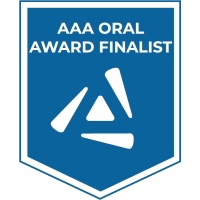Back
ANATOMY
Developmental Biology/Morphology
307.2 - Cochlear Duct Abnormalities in Mice With Osteogenesis Imperfecta
Monday, April 4, 2022
3:30 PM – 3:45 PM
Room: 108 A - Pennsylvania Convention Center
Introduction: H.W. Mossman Award in Developmental Biology Lecture featuring 2022 Early-Career Investigator Award Recipient Yan Jing
Lila Huston (University of North Texas Health Science Center), Rachel Menegaz (University of North Texas Health Science Center), Emma Handler (University of North Texas Health Science Center), Jason Organ (Indiana University School of Medicine), Lauren Gonzales (University of North Texas Health Science Center)
-
Lila Huston
Presenting Author
University of North Texas Health Science Center
Presenting Author(s)
Osteogenesis imperfecta (OI), a developmental disorder of type I collagen, is known to cause hearing loss in ~ 60% of the diseased population. Identified forms include conductive hearing loss (17.4% of OI patients), involving loss of function within the ossicular chain, and sensorineural hearing loss (25.8%), resulting from damage to the cochlea, with the most predominant form being mixed hearing loss (56.8%), involving damage to both the cochlea and ossicles. While OI-related pathologies have largely focused on the middle ear, the pathological appearance of the cochlea (the organ most often compromised in OI-related hearing loss) has gained little focus. In this study, we examine OI-related pathologies on the cochlea in a mouse model for the severe type III OI, to document 1) any visible variation between WT and OI variants, and 2) assess the encroachment of the otic capsule onto the cochlea by analyzing differences in duct volumes. We hypothesize that cochlea in mice with OI will have less consistent morphology overall than their WT counterparts due to abnormal growth of the bony capsule.
16 week old OIM mice (B6C3Fe a/a-Col1a2oim/J) (n=6) were compared to unaffected wildtype (WT) littermates (n=6) with no known hearing defects. High-resolution micro-CT scans were created for all specimens and 3D models and volumes of the cochlea were generated using 3D Slicer software. Two-tailed Mann-Whitney U-tests were used to investigate differences between 1) right and left ears of the same mouse to examine intraindividual symmetry and 2) differences in volumes between WT and OI cochlea.
No major morphologic differences between OI and WT were observed, except for minor areas of higher ossification at the base of the cochlea, mostly within the OI sample. Within WT specimens, we observed little intraindividual difference in the cochlear volume (0-3%). Within OI specimens, significant differences were observed in cochlear volume between right and left ears in the same animal (4-15%; plt;0.05), indicating potential unilateral effects. When average WT and OI volumes were compared, there was much overlap between the two samples although the OI volumes had a significantly larger range than the WT range (Mann-Whitney U, plt;0.05).
Overall, our results indicate that mice with OI are much more likely to have evidence of unilateral cochlear volume losses, despite very little difference in overall shape appearance, possibly due to bony capsule encroachment. This find indicates an extremely high potential for sensorineural and mixed hearing loss in OI-bred mice and elucidates at least one mechanism behind how this type of hearing loss might be occurring.
Little is known about the pathological appearance of the cochlea in OI, leading to difficulty in managing hearing loss. Further investigation of the etiology and progression of cochlear pathologies will allow for better outcomes in hearing for those patients afflicted with OI-related hearing loss.
Funding was provided by an Indiana University Collaborative Research Grant and the Ralph W. and Grace Showalter Trust.
16 week old OIM mice (B6C3Fe a/a-Col1a2oim/J) (n=6) were compared to unaffected wildtype (WT) littermates (n=6) with no known hearing defects. High-resolution micro-CT scans were created for all specimens and 3D models and volumes of the cochlea were generated using 3D Slicer software. Two-tailed Mann-Whitney U-tests were used to investigate differences between 1) right and left ears of the same mouse to examine intraindividual symmetry and 2) differences in volumes between WT and OI cochlea.
No major morphologic differences between OI and WT were observed, except for minor areas of higher ossification at the base of the cochlea, mostly within the OI sample. Within WT specimens, we observed little intraindividual difference in the cochlear volume (0-3%). Within OI specimens, significant differences were observed in cochlear volume between right and left ears in the same animal (4-15%; plt;0.05), indicating potential unilateral effects. When average WT and OI volumes were compared, there was much overlap between the two samples although the OI volumes had a significantly larger range than the WT range (Mann-Whitney U, plt;0.05).
Overall, our results indicate that mice with OI are much more likely to have evidence of unilateral cochlear volume losses, despite very little difference in overall shape appearance, possibly due to bony capsule encroachment. This find indicates an extremely high potential for sensorineural and mixed hearing loss in OI-bred mice and elucidates at least one mechanism behind how this type of hearing loss might be occurring.
Little is known about the pathological appearance of the cochlea in OI, leading to difficulty in managing hearing loss. Further investigation of the etiology and progression of cochlear pathologies will allow for better outcomes in hearing for those patients afflicted with OI-related hearing loss.
Funding was provided by an Indiana University Collaborative Research Grant and the Ralph W. and Grace Showalter Trust.

